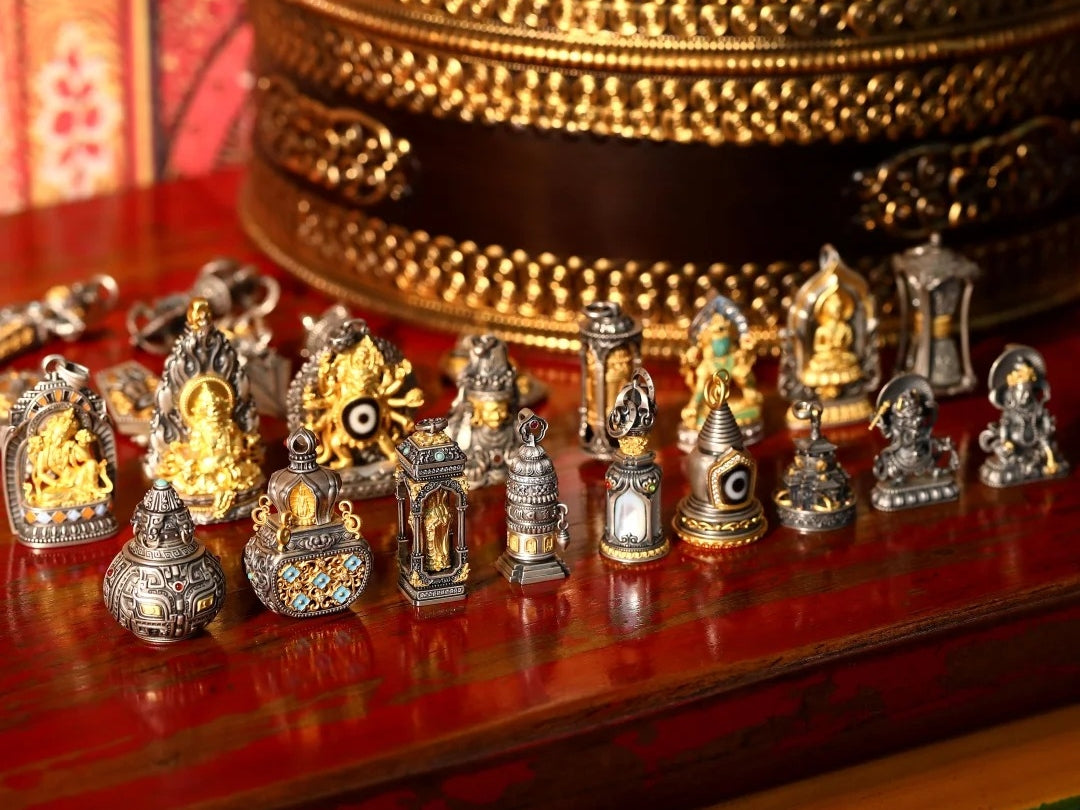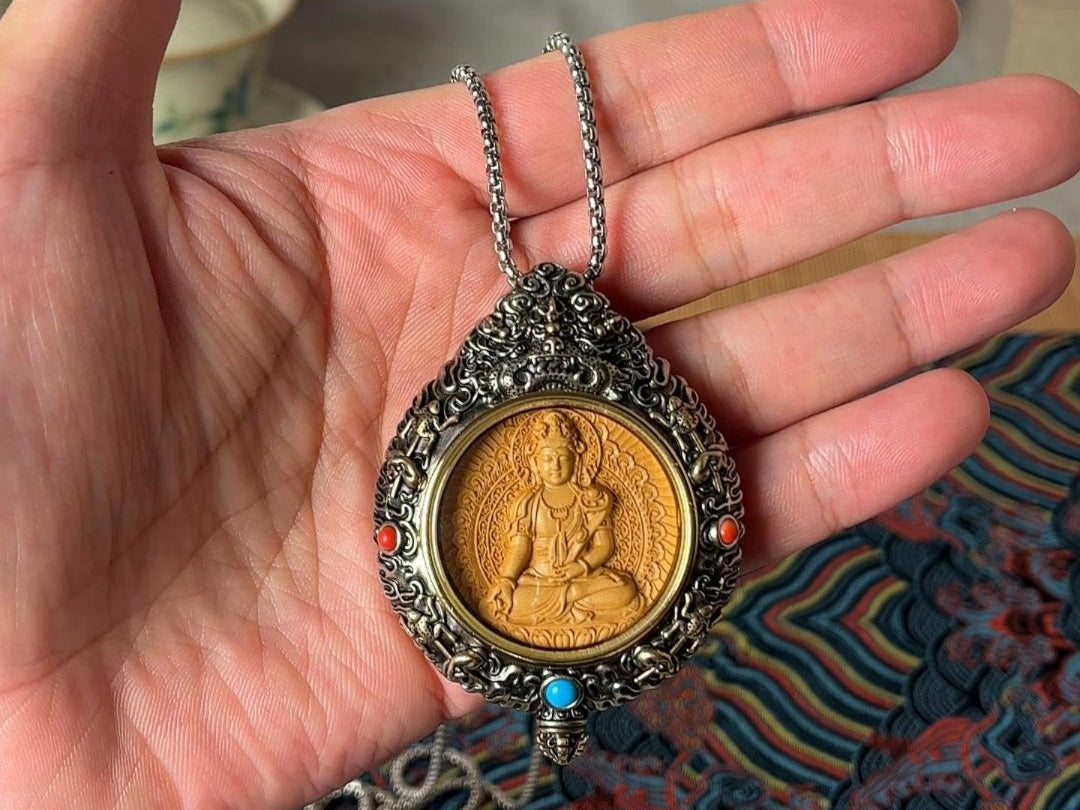For many students and professionals, the work of learning and making career choices can feel like navigating an ocean of information. In Buddhist practice, Akasagarbha—whose name is often translated as “boundless space treasury” or “storehouse of the sky”—is a bodhisattva associated with vast wisdom, memory, and the inner resources needed to learn, teach, and act with confidence. Artisans and designers translate these qualities into wearable talismans—Akasagarbha pendants, engraved rings, and gemstone malas—that help a wearer set intention, steady the mind, and move through study or career transitions with steadier footing.
Below is a practical, culturally mindful overview: who Akasagarbha is in short, how jewelers encode his qualities into pieces, stone and metal choices that support study and career goals, and a one-minute daily practice you can pair with a pendant.
Who is Akasagarbha in a nutshell?
Akasagarbha is a Mahāyāna bodhisattva who embodies the spaciousness of mind and the wealth of inner qualities—especially memory, understanding, and resourcefulness. Devotees invoke him when they seek clearer recollection, better retention of teachings, or the calm confidence to apply knowledge in life and work. While devotional forms and mantras vary across regions, the bodhisattva’s symbolic role as a “treasury of wisdom” is widely recognized.

How artisans translate “wealth of wisdom” into jewelry
Jewelry makers aiming to honor Akasagarbha usually focus on three design goals: clarity, spaciousness, and practical resilience.
• Open, airy forms. Circular, uncluttered designs suggest mental space—simple round pendants, hollowed gawu-style boxes, or ring bands with a clean profile. These shapes are visual reminders to leave mental room for ideas to settle and connect.
• Engraved syllables and mantras. Rather than complex figural scenes, makers often engrave short mantric fragments or seed syllables on the reverse of a pendant or along the inner ring band. Common, approachable forms include variations of the Akasagarbha invocation (pronunciations and transliterations differ by tradition; one accessible form is “Om Akasagarbhaya Namah”). Artists place these inscriptions where they are intimate—against the chest or hidden inside a gawu—so the object can be both wearable and devotional.
• Protective practicality. For daily use, artisans prefer durable metals and secure settings so the object can accompany study sessions, commute rides, and meetings without fuss.
Stones and metals that echo study & career intentions
Design choices for an Akasagarbha talisman are symbolic and personal. Below are choices artisans commonly make, and the intentions they tend to support:
• Lapis lazuli or sodalite (deep blue): long associated with insight and calm concentration—good for analytical study and verbal clarity.
• Clear quartz: amplifies intention and supports focus; versatile and neutral as a meditation aid.
• Citrine or tiger’s eye: chosen when study goals are tied to career outcomes—confidence, practical success, and steady decision-making.
• Turquoise: protective and balancing; useful for students on the move or people under stress.
• Metals—sterling silver and brass: S925 sterling silver reads as refined and ritual-friendly; brass or bronze connects to Himalayan metalworking traditions and wears well over time.
Tip: pick a material that feels right to you. A pendant you enjoy touching and seeing will be a better study cue than one you don’t.
Where designers place meaning
-
Front face: a single stone, minimal symbol, or subtle mandala.
-
Reverse / inner surfaces: short mantra lines, seed syllables, or a tiny gawu compartment for mantric slips.
-
Textures and negative space: deliberate empty areas on a pendant suggest “mental room” and can be as meaningful as carved motifs.
A one-minute daily practice for study or career focus
This short routine is designed to be practical—doable every morning, during a study break, or before an interview.
-
Settle (15 seconds). Hold your Akasagarbha pendant in one hand or place a finger on your ring. Take two slow, full breaths.
-
Recite (20 seconds). Say your chosen mantra quietly or mentally (for example, “Om Akasagarbhaya Namah”) three times. If you prefer, speak a short intention: “May I remember clearly; may this work benefit others.”
-
Visualize & ground (25 seconds). Imagine a soft, clear light expanding behind your forehead and filling your mind like open sky. Place the pendant over your chest (or touch it lightly) and step into the task with one committed action—opening a page, sending an email, starting a practice test.
This micro-ritual combines breath, word, and touch; over time it helps condition attention and links the physical object to a focused mental state.

Respectful use and simple care
Akasagarbha talismans are devotional objects for many people—treat them with the same basic courtesy you’d offer any cultural or spiritual item. Remove jewelry before bathing, avoid placing sacred images on the floor, and keep hand-painted or gawu pieces away from bright sun and moisture. If a piece has been blessed, honor that provenance and follow any care instructions from the maker.
Final note: intention matters more than perfection
Jewelry inspired by Akasagarbha works best when it’s both meaningful and practical. The real power comes not from a design’s exact symbolism but from the wearer’s repeated, intentional use—those small moments when you touch your pendant, breathe, and realign your attention. Whether you’re preparing for exams or navigating a career shift, a thoughtfully chosen Akasagarbha pendant can be a quiet companion: a reminder that wisdom and the resources to act effectively live inside you.






